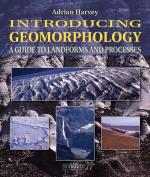|
This section contains 775 words (approx. 3 pages at 300 words per page) |

|
Landforms are the mesoscale topographic features that define a regional landscape. Climate and plate tectonics ultimately determine the system of processes—plate tectonic motion,
 This mother and child are taking advantage of the sea breeze. © Tim Kiusalaas/Corbis. Reproduced by permission.
This mother and child are taking advantage of the sea breeze. © Tim Kiusalaas/Corbis. Reproduced by permission.
gravity, erosion, and deposition by water, wind, and ice—that interact in complex feedback loops to erect and destroy continental landforms. Climate, the regional pattern of seasonal precipitation, temperature, and wind-flow, varies with latitude, altitude, and physiographic location. Motion of Earth's lithospheric plates, called plate tectonics, determines the global geography of mountain chains, volcanoes, continental landmasses, and ocean basins, as well as the distribution of rock types. The morphology of landforms suggests the processes that created them, and landforms are clues to deciphering the present and past geological setting of a region.
Climate often dictates the mix of sedimentary processes acting to create landforms. For example, eolian...
|
This section contains 775 words (approx. 3 pages at 300 words per page) |

|


